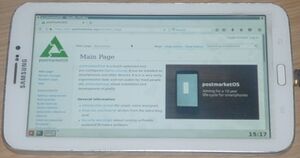Samsung Galaxy Tab 3 7.0 (samsung-lt023g)
| This device runs a Downstream kernel. Some UIs will not work, and most features (3D acceleration, audio, etc.) may be broken. |
 Samsung Galaxy Tab 3 7.0 | |
| Manufacturer | Samsung |
|---|---|
| Name | Galaxy Tab 3 7.0 |
| Codename | samsung-lt023g |
| Released | 2013 |
| Type | tablet |
| Hardware | |
| Chipset | Marvell PXA986 |
| CPU | Dual-core 1.2 GHz Cortex-A9 |
| GPU | Vivante GC1000 |
| Display | 1024×600 TFT |
| Storage | 16GB |
| Memory | 1GB |
| Architecture | armv7 |
| Software | |
Original software The software and version the device was shipped with. |
Android 4.4.2 (Linux 3.4.5) |
Extended version The most recent supported version from the manufacturer. |
Android |
| postmarketOS | |
| Category | downstream |
Mainline Instead of a Linux kernel fork, it is possible to run (Close to) Mainline. |
no |
pmOS kernel The kernel version that runs on the device's port. |
3.4.113 |
Unixbench score Unixbench Whetstone/Dhrystone score. See Unixbench. |
564.6 |
| Device package |
|
| Kernel package |
|
Flashing Whether it is possible to flash the device with pmbootstrap flasher. |
Works
|
|---|---|
USB Networking After connecting the device with USB to your PC, you can connect to it via telnet (initramfs) or SSH (booted system). |
Works
|
Battery Whether charging and battery level reporting work. |
Works
|
Screen Whether the display works; ideally with sleep mode and brightness control. |
Works
|
Touchscreen |
Works
|
| Multimedia | |
3D Acceleration |
Broken
|
Audio Audio playback, microphone, headset and buttons. |
Works
|
Camera |
Works
|
| Connectivity | |
WiFi |
Partial
|
Bluetooth |
Partial
|
GPS |
Untested
|
| Modem | |
Calls |
Broken
|
SMS |
Broken
|
Mobile data |
Broken
|
| Miscellaneous | |
FDE Full disk encryption and unlocking with unl0kr. |
Works
|
| Sensors | |
Accelerometer Handles automatic screen rotation in many interfaces. |
Works
|

Maintainer
- hpagseddy
Users owning this device
- Adam12a12 (Notes: lt02wifi, WiFi not working)
- Agar (Notes: 8GB, Childhood tablet which introduced me to the Android Modding scene)
- Alex58
- AmateurPenguin (Notes: White and 47 cents)
- Catto24 (Notes: lt02wifi - stock kitkat)
- Cdde (Notes: Broken-ish WiFi)
- Devon (Notes: Works great. Wifi works.)
- Gissf1 (Notes: 8GB WiFi only model (lt02wifi), installed to USER partition. Both WiFi and BT are not working yet)
- H3 (Notes: pmOS installed. lxqt desktop. loads wifi firmware with hacky fix. shows networks but won't connect)
- Hacker420
- Marineboy1
- MoralCode (Notes: Broken-ish WiFi)
- Olofolleola4 (Notes: SM-T210 (samsung-lt02wifi) - postmarketOS edge)
- Randomtek (Notes: Kids' version (SM-T2105))
- Rontti (Notes: rootfs only worked on SD card and USER partition)
- Swee (Notes: T-Mobile variant (lt02ltetmo, SM-T217T), runs unofficial build of LineageOS, refuses to boot PostmarketOS)
- Tfuxu (Notes: Nice old tablet for reading and listening to books, only crippled by its SOC and 1GB of RAM)
- Threeoh6000 (Notes: Kids Edition, works fine, xfce4)
- Ysh (Notes: lt02wifi 8GB)
Entering flash mode
- Power down the device, then press and hold
Volume Down+Home+Powersimultaneously. - Once the device vibrates, release
Power, but keepVolume DownandHomeheld. - The device will ask you if you wish to upload a custom OS. Press
Volume Upto confirm. - Once the device displays "Odin mode" in the top-left of the screen, it is ready for flashing.
Entering recovery mode
- Power down the device, then press and hold
Volume Up+Home+Powersimultaneously. - Once the device vibrates, release
Power, but keepVolume UpandHomeheld.
Installation
Refer to Installation/Using pmbootstrap for more details.
During pmbootstrap init, select
- Channel:
edge - Vendor:
samsung - Device codename:
lt023g wpa_supplicantas the wifi backend- User interface:
lxqt(recommended, see Incompatible software below for more details; only software rendering is supported) - Additional options: extra free space:
500MB (not needed when installing to sdcard) - Extra packages:
linux-firmware-mrvl,zstd,networkmanager,networkmanager-clifor wifi firmware, and to allow connecting to wifi using either lxqt nm-applet or the command line interface. See How to get WiFi working for more details.
Before running pmbootstrap install to generate the kernel and rootfs images, you need to choose the rootfs location from the following three options.
- USERDATA partition: Change
deviceinfo_flash_heimdall_partition_systemin deviceinfo toUSERand usepmbootstrap flasher flash_rootfsto flash the rootfs after generating the image. (Flashing to SYSTEM with heimdall fails.) - External sd card: Add the
--sdcard=/dev/mmcblk...flag. - Installation from recovery mode using a zip file: Add the
--android-recovery-zipflag.
Full disk encryption is supported with all of the above options, and is enabled by adding the --fde flag.
Kernel can be installed via pmbootstrap flasher flash_kernel after entering flash mode.
What works
See devicetable on the right.
- Booting off a microSD card
- Booting from userdata partition
- Booting from system partition using Android recovery ZIP option
- Physical buttons
- Touch keys
- Backlight brightness
- Battery indicator
- Wayland
- X11
- Front and back Camera (/dev/video0 - front camera, /dev/video1 - back camera)
- Sensors
- Bluetooth (only shows available devices. Still looking for a way to connect to a device)
- Audio
What does not work
- Cellular networking(not exist on some models)
- 2D and 3D Acceleration
Everything else is untested as of writing this.
Incompatible software
Due to the lack of upstream support for the PXA986 SoC, the kernel remains to a very old 3.4.113 version. As of 2023, there is still largely chance that the software on the edge channel of postmarketOS will run on this device with some notable exceptions. Concerning the choice of the environment, LXQt works out of the box. It has been reported that Xfce4, GNOME, and MATE never reach the desktop.
Some issues related to general software:
- Software using sandboxing will fail (e.g. epiphany browser). Of course, this includes all flatpaks as well
- /etc/fstab cannot be used to mount a partition (an unsupported kernel syscall in newer versions of mount prevents the access to the file)
- Some programs will just fail to start
How hpagseddy get camera working
Right now it's not usable for daily use, just for testing camera quality and checking if camera is working or not. I used the "motion" package from Alpine Linux to capture pictures. If you want to test it too, just use apk add motion command to install that package. Then simply type "motion" and it will start capturing pictures nearly every second. If it doesn't capture pictures or pictures are just black squares then your camera isn't working. For opening pictures, I used feh image viewer to view images but every gallery app works great.
How to get WiFi working
Install linux-firmware-mrvl to get the necessary firmware files. Navigate to /lib/firmware/mrvl and run sudo unzstd *.bin.zst --force to extract firmware (as the kernel does not support compressed firmware), then reboot the device via sudo reboot.
Run sudo ifconfig mlan0 up, then configure wpa_supplicant:
$ wpa_passphrase "YOUR_SSID" "YOUR_PASSPHRASE" | sudo tee /etc/wpa_supplicant/wpa_supplicant.conf
Then run:
sudo rc-service wpa_supplicant start sudo udhcpc -i mlan0
If the service fails to start, you might need to kill the existing process:
sudo killall wpa_supplicant
Note: You need to turn rndis0 off using sudo ifconfig rndis0 down if you used USB Internet. Also remove usb_internet.start from /etc/local.d.
You can also try running wpa_supplicant manually:
sudo wpa_supplicant -u -Dnl80211 -B -c /etc/wpa_supplicant/wpa_supplicant.conf -imlan0
You can also use NetworkManager. Stop and disable wpa_supplicant, then restart and enable NetworkManager (sudo rc-service wpa_supplicant stop; sudo rc-update del wpa_supplicant; sudo rc-service networkmanager restart; sudo rc-update add networkmanager). After connecting to a hotspot, run udhcpc to get a DHCP lease: sudo udhcpc -i mlan0.
About GPU
The GPU is Vivante GC1000 which has open source drivers but we can't get it work yet. The reverse engineered driver is called etnaviv and the compiling process is a little bit complex. If anyone figures it out don't forget to tag @hpagseddy at postmarketOS Matrix server.
Wayland works, but you may get better battery life with X11 (tested GNOME vs MATE).
Mainline
The PXA986 SoC has no support upstream (https://www.kernel.org/doc/html/latest/arm/marvell.html#mmp-mmp2-mmp3-family-communication-processor).
Links
- Wikipedia page for device
- Kernel source 3.4.113
- Unofficial TWRP
- !1484 Add support for the Samsung Galaxy Tab 3 7.0 (lt023g)
- Vivante Open source drivers
- Old Kernel 3.4.5
- sibling model Galaxy Tab 3 Lite 7.0 (samsung-goyawifi)
- Seems to share the chipset, but not the wifi (firmware 8777 vs. 8787 iirc); has some quality of life improvements over this one, eg. Install and use dhclient for networkmanager to get IP throught DHCP